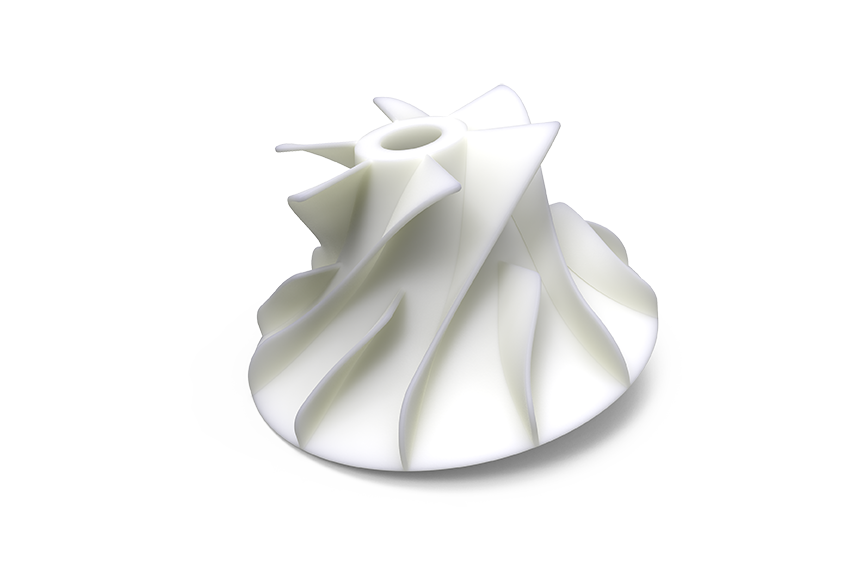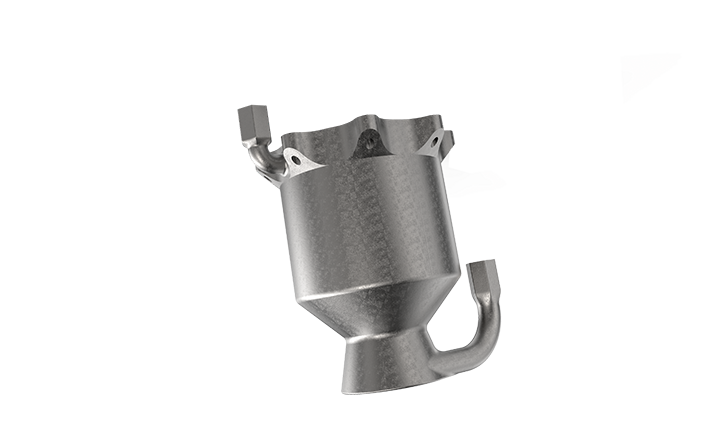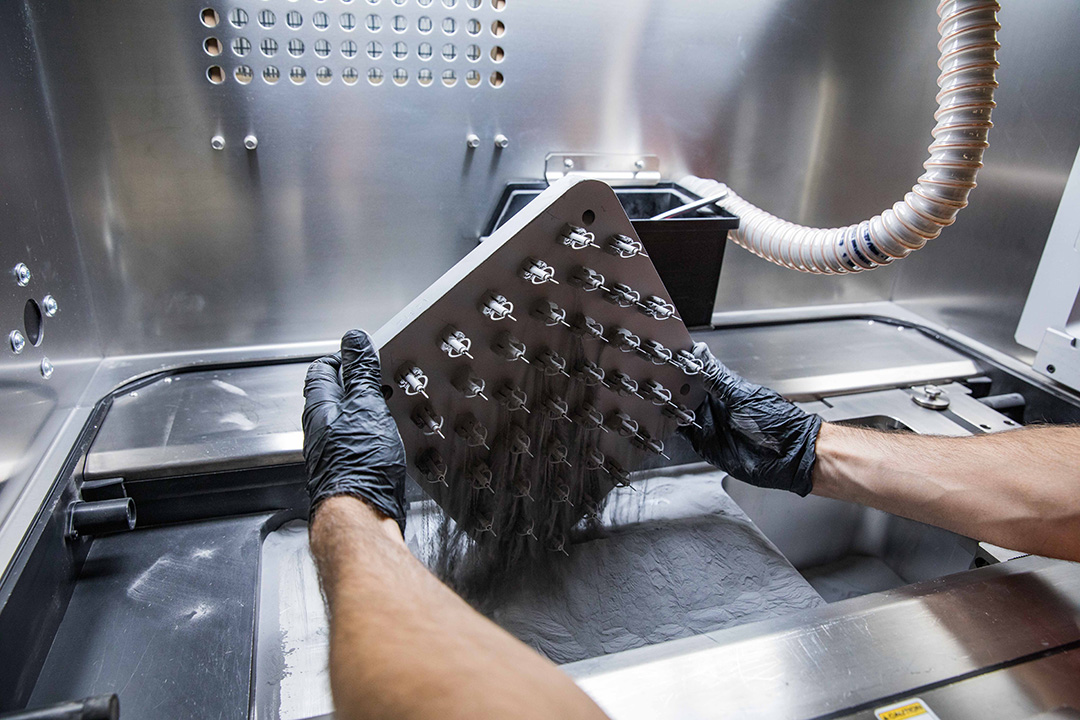![DMLS 3D printing [Image: Protolabs]](https://fabbaloo.com/wp-content/uploads/2020/05/DMLS-process-40-0972-lr_img_5eb0a7ea5e9c8.jpg)
As 3D printing, particularly metal, advances toward production, service providers are taking notice: an interview with Protolabs.
Protolabs, headquartered in Minnesota, is focused on solutions in digital manufacturing, offering services in rapid prototyping and on-demand production. Additive manufacturing has a solid place in the company’s portfolio, as Protolabs offers five 3D printing technologies alongside traditional techniques such as CNC machining and injection molding. The company’s dedicated 3D printing facility in North Carolina occupies 77,000 square feet, houses more than 100 3D printers, and employs about 200.
Greg Thompson, Global Product Manager for 3D Printing at Protolabs, offers insights into operations and his perspective on the rise of additive manufacturing for production in our interview.
![Greg Thompson, Global Product Manager for 3D Printing [Image: Protolabs]](https://fabbaloo.com/wp-content/uploads/2020/05/GregThompson-5699_img_5eb0a7eaed901.jpg)
Can you share with us a look at how Protolabs has integrated 3D printing into its technology portfolio?
“At Protolabs, we’ve taken the approach of letting our customers and their projects’ requirements dictate what technology is best suited for their specific needs. We are a technology-agnostic service provider, meaning in addition to five different additive technologies, we also offer digitally-enabled injection molding, CNC machining, and sheet metal fabrication services through our online quoting and design analysis portals. We are always evaluating other emerging technologies and certainly plan to expand our current portfolio to continue to provide the broadest set of manufacturing technologies to our customers.”
What are some of the most common requests customers have for 3D printing services?
“The strong majority of our customer requests can fall into one of three categories. The first and largest are prototypes, early copies of parts to evaluate the design before moving towards producing higher volumes with more conventional manufacturing. The second is custom tools used in manufacturing. These could be things like custom brackets, spray nozzles, or hand tools. The third is low volume production parts. Production parts in 3D printing are typically high value parts with lots of complexity.”
How have you seen 3D printing move from prototyping toward end-use production?
“Having been in the additive manufacturing industry for nearly 20 years now, it’s been really exciting to experience the additive evolution first-hand. And the most exciting thing is that we’re just getting started – as more advanced materials are developed and production economics get even more favorable, 3D printing will only continue to gain traction as a viable production method for numerous applications. We’ve seen many of our customers, particularly in the aerospace industry, adopt metal 3D printing for not only prototyping but also end-use production. Also, we’ve seen an increase in adoption of nylon-based technologies, such as Multi Jet Fusion and selective laser sintering, for end-use applications in short-runs.”


How do metal technologies fit into this transition?
“3D printing metal technologies are starting to make sense for end-use production for two main reasons: material properties and design freedom. The materials that are used in DMLS are powder alloys with the same chemical composition as their wrought equivalent. The build process produces parts with near 100% density so the material properties after heat treatment are comparable to wrought. Without having to sacrifice material performance, now engineers can look to optimize geometries to save cost. This can be done in many ways such as reducing components, reducing weight, and reducing assembly times.”
Can metal 3D printing offer scale production of end-use parts?
“Absolutely, if the part is a good candidate. Just because the parts can be printed doesn’t always mean they should. Traditional processes such as machining or injection molding will still make sense for parts that are optimally designed for those processes. With 3D metal printing, we’re seeing a growing number of cases where parts are hard to make any other way and therefore are great candidates for production. Typically these parts have a high level of complexity, or demand extremely specialized materials, that would be cost prohibitive to machine.”
What needs to happen for scale production to become a reality in terms of technologies? Materials? Businesses?
“3D printing is already used today in nearly every industry across a range of ever-expanding applications. We find 3D printed parts in human bodies, on airplanes, in space, in hospitals, and used in many other astonishing ways which speak to the true potential of 3D printing technology. Wider use of 3D printing at scale will become even more pervasive when multiple forces converge: technical advancements in materials, economic efficiencies in costs and build speeds, development of a more robust infrastructure and supply chain, and design adoption and knowledge of how to take advantage of 3D printing within the complete value chain.”
![Protolabs' DMLS installation at its Cary, North Carolina facility [Image: Protolabs]](https://fabbaloo.com/wp-content/uploads/2020/05/DMLS-scale-0204-lr_img_5eb0a7ec321ac.jpg)
How does Protolabs see the place of additive manufacturing as a part of the greater manufacturing industry today? In the next year? Five years? Ten?
“Today, many engineers are starting to evaluate 3D printing as a potential manufacturing method for both prototype and end-use parts. In that way, 3D printing is continuing to influence both product design and production. However, businesses often make the mistake of considering 3D printing as a simple replacement of an existing manufacturing technology, and this usually doesn’t work. The real value comes from enabling designs or design cycles previously unachievable via conventional methods. Good examples are combining a number of assemblies into a single part, improving performance with organic geometries, or reducing overall material and weight in a part. Over the next few years, as understanding grows of when 3D printing creates value, it will further expand as another tool manufacturers and engineers use, alongside the traditional manufacturing methods, to create the best, most cost-efficient designs for their projects.”
What else should we know about metal 3D printing for volume production?
“A well-designed part is critical for volume production. Like all manufacturing process there are design rules that must be taken into consideration. For metal printing, it’s important to visualize how a part is going to grow layer-by-layer and reduce overhanging features and large changes in cross-sectional area. Learning how to design a ‘self-supporting’ part will greatly reduce the build time and the amount of secondary finishing time required.”
Take a look inside Protolabs’ operations in this video tour:
Via Protolabs











A blog post reveals much of what happens behind the scenes at 3D print service Shapeways.